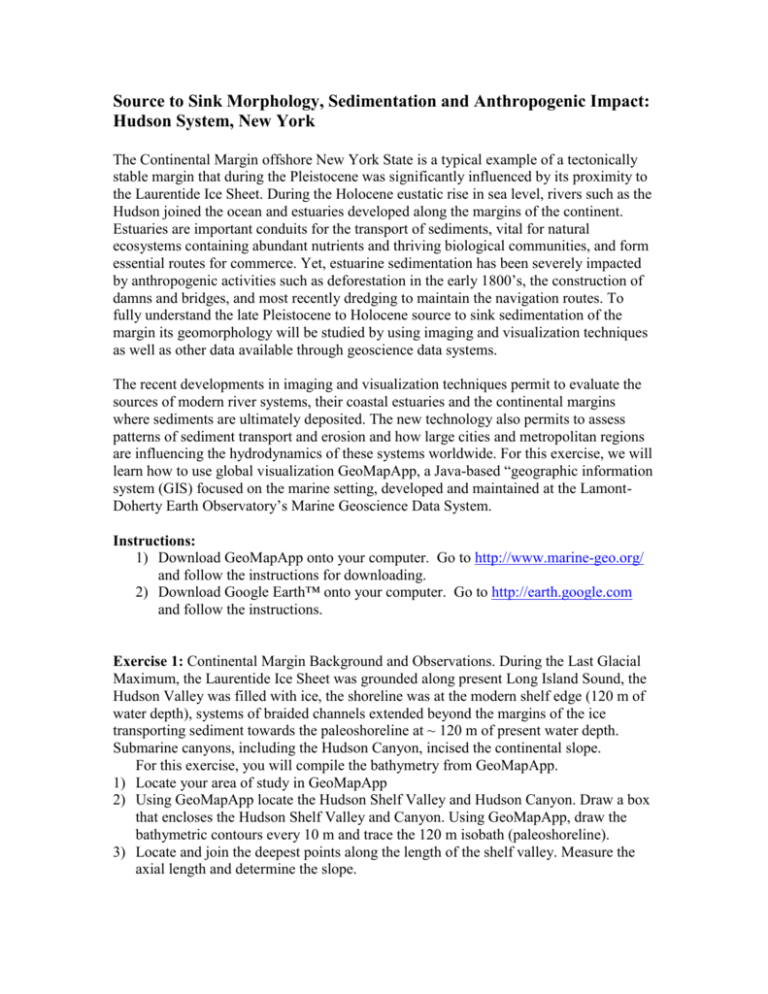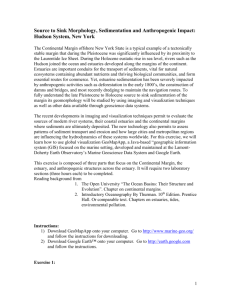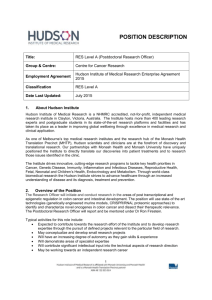Plate Tectonics as Expressed in Geological
advertisement

Source to Sink Morphology, Sedimentation and Anthropogenic Impact: Hudson System, New York The Continental Margin offshore New York State is a typical example of a tectonically stable margin that during the Pleistocene was significantly influenced by its proximity to the Laurentide Ice Sheet. During the Holocene eustatic rise in sea level, rivers such as the Hudson joined the ocean and estuaries developed along the margins of the continent. Estuaries are important conduits for the transport of sediments, vital for natural ecosystems containing abundant nutrients and thriving biological communities, and form essential routes for commerce. Yet, estuarine sedimentation has been severely impacted by anthropogenic activities such as deforestation in the early 1800’s, the construction of damns and bridges, and most recently dredging to maintain the navigation routes. To fully understand the late Pleistocene to Holocene source to sink sedimentation of the margin its geomorphology will be studied by using imaging and visualization techniques as well as other data available through geoscience data systems. The recent developments in imaging and visualization techniques permit to evaluate the sources of modern river systems, their coastal estuaries and the continental margins where sediments are ultimately deposited. The new technology also permits to assess patterns of sediment transport and erosion and how large cities and metropolitan regions are influencing the hydrodynamics of these systems worldwide. For this exercise, we will learn how to use global visualization GeoMapApp, a Java-based “geographic information system (GIS) focused on the marine setting, developed and maintained at the LamontDoherty Earth Observatory’s Marine Geoscience Data System. Instructions: 1) Download GeoMapApp onto your computer. Go to http://www.marine-geo.org/ and follow the instructions for downloading. 2) Download Google Earth™ onto your computer. Go to http://earth.google.com and follow the instructions. Exercise 1: Continental Margin Background and Observations. During the Last Glacial Maximum, the Laurentide Ice Sheet was grounded along present Long Island Sound, the Hudson Valley was filled with ice, the shoreline was at the modern shelf edge (120 m of water depth), systems of braided channels extended beyond the margins of the ice transporting sediment towards the paleoshoreline at ~ 120 m of present water depth. Submarine canyons, including the Hudson Canyon, incised the continental slope. For this exercise, you will compile the bathymetry from GeoMapApp. 1) Locate your area of study in GeoMapApp 2) Using GeoMapApp locate the Hudson Shelf Valley and Hudson Canyon. Draw a box that encloses the Hudson Shelf Valley and Canyon. Using GeoMapApp, draw the bathymetric contours every 10 m and trace the 120 m isobath (paleoshoreline). 3) Locate and join the deepest points along the length of the shelf valley. Measure the axial length and determine the slope. 4) Locate the deepest parts of the canyon floor along the length of the canyon. Join the points, measure the axial length and determine the slope. 5) What are the main differences in water depths, lengths and slopes between the shelf valley and canyon? 6) Draw four cross-sectional profiles across the shelf valley and canyon, respectively. How do the cross-sectional profiles change with increasing water depth? 7) What do these differences in morphology between the shelf valley and canyon reveal about sediment transport and erosion? If a system becomes larger (deeper and wider) with time, which system is more mature the canyon or shelf valley? Why? Exercise 2: Source to sink sedimentation from the Hudson River watershed to the continental shelf. This part of the exercise will introduce students to the geomorphology of estuaries and how this morphology changes along the estuary. Two major variables will be highlighted: 1) the adjacent physiography and how it influences the morphology of the estuary and 2) the energy of the system based on grain size variability. The assumption is that coarser grained sands require more energy for transport and that sand is required to form sediment waves. For this part of the exercise, you will compile the bathymetry of the Hudson River estuary and adjacent topography from GeoMapApp. 8) How long is the Hudson River estuary from Troy, NY to its mouth in the New York Harbor? 9) Divide the river into six segments. What is the average width and length of each segment? 10) Based on these measurements how does the estuary change along its length? Is there a relation between changes in the morphology of the estuary (width, water depth) and the adjacent physiography? 11) Inspect each section at very high-resolution. Are there any sediment waves along the river floor? Where are the sediment waves most common to the north near Troy or south near New York Harbor? Or both? If sediment waves need sand to be formed, and based on your observations, where is the sand found in the Hudson River system? If more energy is needed to transport the sand, where is the estuary more energetic? Exercise 3: In this part of the exercise, the students will assess the impact of anthropogenic activities on the sedimentation and environment. For this part of the exercise, you will compile the bathymetry and topography from GeoMapApp, and anthropogenic structures Google Earth™ http://earth.google.com Anthropogenic Impact: 12) How many bridges cross the Hudson River? What are their names? How long are these bridges and what is the distance between them in kilometers? 13) Locate the channel in those parts of the estuary that are crossed by the bridges. Is there a well-defined channel present along these segments? If not, what do you think is happening? How are the bridge structures interfering with the circulation of the estuary? 14) The navigation routes need to be maintained open for the transport of goods and dredging is common along coastal estuaries. Using Google Earth locate areas where the ships dock. Where in the Hudson, would you expect to find the greatest impact to ecosystems due to dredging? Goals: Familiarize students with the morphology of passive continental margins and their associated estuaries, and assess the anthropogenic impact. There will be four steps to this exercise: 1) relate the geomorphology of the continental margin to its evolution within the framework of longer-term processes: climate and eustasy; 2) relate the morphology of the estuary to the local physiography to understand sediment transport and erosion; 3) at high-resolution identify sediment bedforms on the estuarine floor and make inferences about the energy of the system; 4) show students how humans are modifying these systems and what are the consequences of these activities on the environment. Context for Use: The mini-lesson will be used for an introductory geology and/or environmental science classes in Oceanography. The students are geology and/or environmental science majors on their freshmen to sophomore years. This exercise will be conducted as part of a short (50 ‘ lecture) and longer (3 hour) laboratory where small student groups are expected to interact and exchange ideas while learning about the seafloor and sedimentation processes. The students will need to have access to computer terminals and will learn to master the use of data-bases. This activity could be easily adapted for other settings and also for other geological problems. Teaching Materials: Reading background from 1. The Open University “The Ocean Basins: Their Structure and Evolution”. Chapter on continental margins. 2. Introductory Oceanography By Thurman. 10th Edition. Prentice Hall. Or comparable text. Chapters on estuaries and tides. Several files to be produced. Assessment: 1) The projects will be discussed in class. 2) The students will be required to write a term paper or prepare a 2nd class project that applies the concepts learnt in this laboratory to a topic of their choice. 3) A power point presentation of their project or term paper will be given to the class for additional feed back. Resources: 1) GeoMapApp http://www.marine-geo.org/ 2) Google Earth™ http://earth.google.com Short Description: Application of sea-floor web resources to the undergraduate curriculum.






